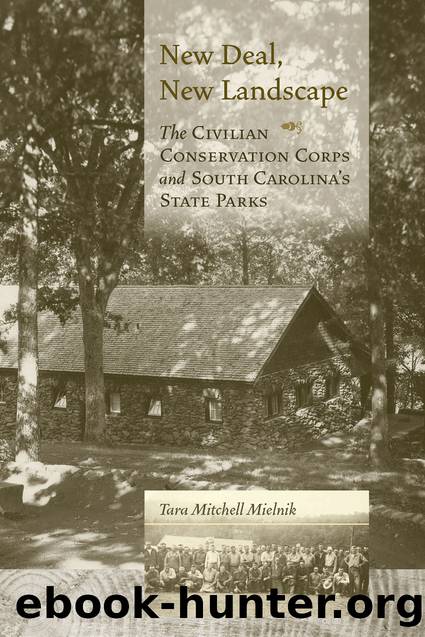New Deal, New Landscape by Mielnik Tara Mitchell;

Author:Mielnik, Tara Mitchell;
Language: eng
Format: epub
Publisher: University of South Carolina Press
Published: 2011-08-15T00:00:00+00:00
Kings Mountain National Military Battlefield, near York. The headquarters building at Kings Mountain demonstrates the CCC version of the Colonial Revival style. Photograph by the author
In addition to the construction work at Kings Mountain, CCC enrollees found themselves doing a variety of work, as did most enrollees. The young men worked as foresters, truck drivers, cooks, mechanics, medical aids, masons, and landscapers, among a plethora of other occupations. One position at Kings Mountain was fairly unique, however. After building the âVisitorâs House,â a log structure designed to look like a pioneer cabin, two CCC boys were housed there on weekends, and served as interpretative guides for the battlefield.58
Other New Dealâera buildings still exist in the part of the RDA that was turned over to the state in 1942, including an elaborate stone bathhouse, picnic shelters, cabins, and numerous other structures such as water fountains, walls, roads, and trails. Although most of the shelters and other buildings that the CCC built at Kings Mountain are very similar to the picnic shelters and other structures at other South Carolina state parks, one picnic shelter at the RDA is unique. Shelter 1 (now identified as KM-S1) features an enclosed gable end made of round peeled log, rather than frame as in many of the other enclosed shelters. While the CCC and NPS tried to use natural materials as much as possible, they also tried to invoke the history of the area, and the log structure at Kings Mountain State Park should remind visitors of the typical log cabins that were home to the Over-mountain Men of the Carolinas who fought for the Patriots at Kings Mountain. The log shelter also features a stone chimney in the enclosed end, with a stone fireplace and brick-lined firebox.
The CCC also constructed two dams, creating two lakes, including the 8.5-acre Lake Robert Crawford, the focal point of the day-use area at the state park, and the 62.5-acre Lake York, created for the parkâs two group camps. The group camps, Camp York and Camp Cherokee, were designed with similar goals as the group camps at the Cheraw RDA, so that the âunderprivileged children, farm clubs, and groups from the cities will be enabled to enjoy the healthful outdoor life during the summer months, at a low cost, under proper supervision,â as stated by the State Forestry Commission.59 Both camps feature a mess hall, staff quarters, and administration building, with cabin groups and latrines. Camp York has thirty sleeping cabins of four distinct types, all generally rectangular in shape with gable roofs, and primarily board-and-batten siding, with porches on the front of three of the four cabin types. Camp Cherokee features similar buildings, but as at Cheraw State Camp, this group camp is simpler architecturally. There are two cabin types at Camp Cherokee; as at Camp York, the cabins are rectangular in plan with gable roofs, and of board-and-batten siding, with weatherboard siding in the gable ends. One group of the cabin types (six cabins) features projecting front porches with a gable roof, while the other type (sixteen cabins) do not have porches.
Download
This site does not store any files on its server. We only index and link to content provided by other sites. Please contact the content providers to delete copyright contents if any and email us, we'll remove relevant links or contents immediately.
The Lonely City by Olivia Laing(4572)
Animal Frequency by Melissa Alvarez(4156)
All Creatures Great and Small by James Herriot(3989)
Walking by Henry David Thoreau(3685)
Exit West by Mohsin Hamid(3637)
Origin Story: A Big History of Everything by David Christian(3473)
COSMOS by Carl Sagan(3353)
How to Read Water: Clues and Patterns from Puddles to the Sea (Natural Navigation) by Tristan Gooley(3242)
Hedgerow by John Wright(3110)
How to Do Nothing by Jenny Odell(3103)
The Inner Life of Animals by Peter Wohlleben(3101)
How to Read Nature by Tristan Gooley(3081)
Project Animal Farm: An Accidental Journey into the Secret World of Farming and the Truth About Our Food by Sonia Faruqi(3019)
Origin Story by David Christian(2997)
Water by Ian Miller(2957)
A Forest Journey by John Perlin(2918)
The Plant Messiah by Carlos Magdalena(2751)
A Wilder Time by William E. Glassley(2691)
Forests: A Very Short Introduction by Jaboury Ghazoul(2671)
